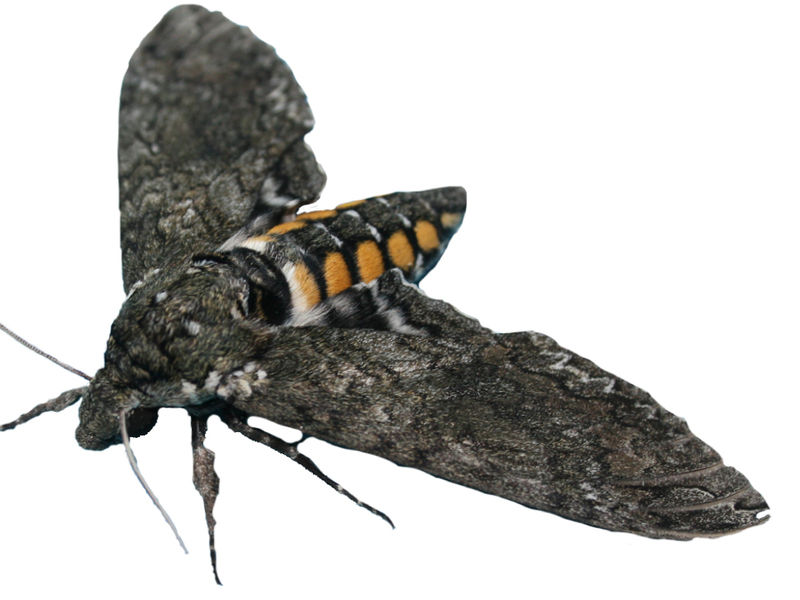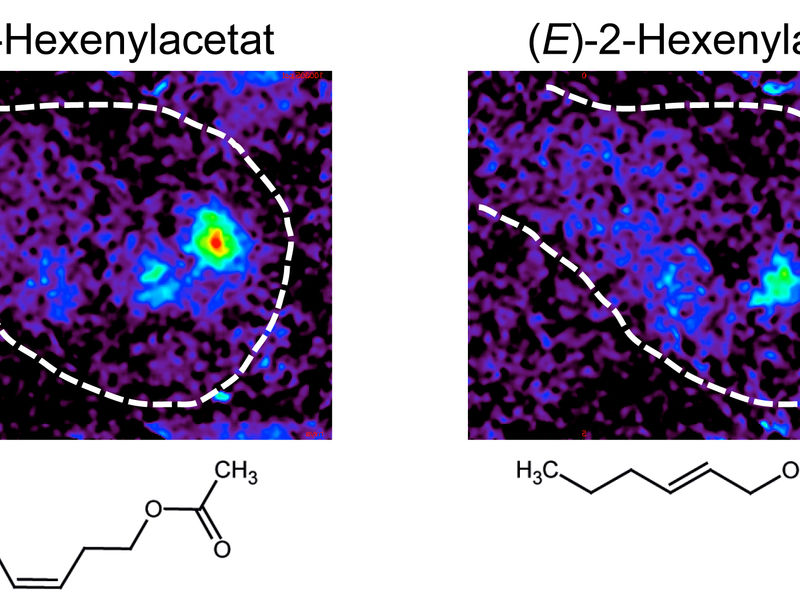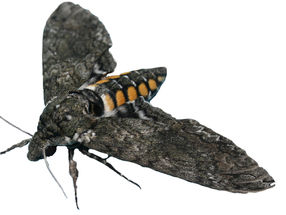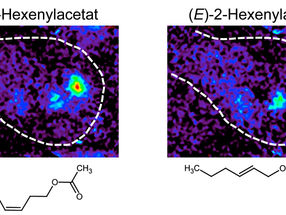Female moths use olfactory signals to choose the best egg-laying sites
Small changes in the composition of green leaf volatiles induced by herbivory guide ovipositing female moths to unattacked plants
Advertisement
Researchers at the Max Planck Institute for Chemical Ecology, Jena, Germany, discovered that the ability of Manduca sexta moths to recognize changes in the profile of volatile compounds released by plants being attacked by Manduca caterpillars allows them to lay their eggs on plants that are less likely to be attacked by insects and other predators, and to avoid competing against other caterpillars of the same species for resources.

The female hawkmoth (Manduca sexta).
© MPI f. Chemical Ecology/Linda Kübler

Different activation patterns (red spots) can be observed in the antennal lobes of a female Manduca sexta moth’s brain depending on whether the moths respond to (Z)-3-hexenyl acetate (left) or (E)-2-hexenyl acetate (middle). The odour of a (Z)-3-isomer or a (Z)-3 / (E)-2 ratio in favour of a (Z)-3-isomer − according to the odour bouquet of an unattacked plant − guides ovipositing Manduca females to plants that have yet been spared by herbivorous caterpillars.
© Anna Späthe, Linda Kübler, Max Planck Institute for Chemical Ecology


Plants have developed many different strategies to defend themselves against herbivorous animals, particularly insects. In addition to mechanical defences such as thorns and spines, plants also produce compounds that keep insects and other herbivores at bay by acting as repellents or toxins. Some of these metabolites are produced on a continuous basis by plants, whereas others – notably compounds called green-leaf volatiles – are mainly produced once the plant has been wounded or attacked. Green-leaf volatiles – which are also responsible for the smell of freshly cut grass – have been observed to provide plants with both direct protection, by inhibiting or repelling herbivores, and indirect protection, by attracting predators of the herbivores themselves.
The hawkmoth Manduca sexta lays its eggs on various plants, including tobacco and Sacred Datura plants (Datura wrightii). Once the eggs have hatched into caterpillars, they start eating the leaves of their host plant, and if present in large numbers, these caterpillars can quickly defoliate and destroy the plant. In an effort to defend itself, the host plant releases green-leaf volatiles to attract various species of Geocoris, predatory bugs that eat insect eggs and tiny larvae.
One of these green-leaf volatiles released by tobacco plants is known as (Z)-3-hexenyl acetate, but enzymes released by M. sexta caterpillars’ spit change some of these molecules into (E)-2-hexenyl acetate, which has the same chemical composition but a different structure. The resulting changes in the volatile profile alerts Geocoris bugs to the presence of M. sexta caterpillars on the plant − their potential prey.
Now the scientists from the Max Planck Institute for Chemical Ecology show another interesting effect of the chemical “odour conversion”: Just like Geocoris bugs, adult female M. sexta moths are able to detect the changes in the green volatile profile emitted by Sacred Datura plants that have been damaged by M. sexta caterpillars. This alerts the moths to the fact that Geocoris bugs are likely to predate eggs and caterpillars on the plant, and as a consequence the moths lay their eggs on unattacked plants. Hereby they minimize the risk of newly laid eggs being eaten by the predators. Another plant is reduced.
The researchers also identified the neural mechanism that allows moths to detect the slightest changes in the volatile profile of plants that have already been attacked by caterpillars. Neurobiological studies of the moth brain revealed that E- and Z- odours lead to different activation patterns. The two isomers of hexenyl acetate activated different regions in the antennal lobe of the moth. “This suggests that the female moths have isomer-specific receptors and neurons on their antennae,” says Bill Hansson, director of the institute. The combination of such neurological experiments and ecological field studies are very promising and may provide further insights into odour-guided behaviour of insects in nature and agriculture.
A similar behavioural pattern is known from potato beetles (Leptinotarsa decemlineata). An artificial application of (Z)-3- or (E)-2-hexenol, (E)-2-hexanal or 1-hexanol to potato plants lead to a disoriented behaviour observed in egg-laying potato beetles. On the basis of these results, plant protection strategies seem possible which utilize artificial odour application in order to deter ovipositing insects from field crops and thereby reduce insect infestation.























































